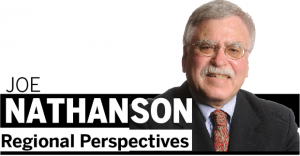
Playing ball in Baltimore
Joe Nathanson
March 1, 2024
Cities have complicated relationships with their sports teams. They go to great lengths to secure major league teams and, perhaps, to even greater lengths to retain them. Conferring major league status on a community is seen as an important component of economic development, enhancing the area’s ability to attract and retain businesses, and it’s a matter of civic pride.
Baltimore has certainly experienced the highs and lows of sports fandom. The move of baseball’s St. Louis Browns to Baltimore, where they became the Orioles, brought elation in 1954. The clandestine departure in the dead of night of the beloved Baltimore Colts as they were spirited off to Indianapolis sank this area into desolation in 1984.
After the glory years at Memorial Stadium, including World Series wins in 1966, 1970 and 1983, it was essential to keep the baseball team in Baltimore, but on a new playing field. A spirited debate arose regarding the location of a new stadium.
There was support in some quarters for a new facility near the southwest segment of the Baltimore Beltway, presumably to draw fans from the Washington area (which hadn’t yet secured a new team after the Senators decamped decades earlier). But with even stronger support, led by then-Mayor William Donald Schaefer, for a decision to build Oriole Park at Camden Yards, the new stadium buttressed the hotels, restaurants and bars of Baltimore’s downtown and set a new standard for the design of new playing fields in other cities.
The National Football League also saw the wisdom of returning to Baltimore. After being snubbed by former NFL Commissioner Paul (“build a museum”) Tagliabue during an earlier expansion plan, the league allowed for the transfer of the Cleveland Browns franchise, and the Baltimore Ravens joined the local scene in 1996. This led to another great investment in sports venues with the building of what is now named M&T Bank Stadium, under the auspices of the Maryland Stadium Authority, just a parking lot expanse away from Oriole Park.
Moving forward a generation or two, it seems that just building a sports stadium is not enough to satisfy local development ambitions. It’s now a stadium plus an entertainment district.
This trend seems to have started when the Atlanta Braves made the decision about a decade ago to move out of Turner Field in downtown Atlanta and relocate to a site in suburban Cobb County. Starting in 2017 the Braves have played in what is now known as Truist Park. The new field and the adjoining district designated The Battery Atlanta, a mix of retail shops, restaurants, residential and entertainment uses, represents a combined public-private investment of $1.1 billion.
Apparently, it was this model that Orioles owner John Angelos envisioned as he was negotiating a long-term lease extension with the stadium authority. The tortuous negotiations did eventually lead to a lease extension, but without the Orioles gaining the desired development rights for an entertainment district.
Soon thereafter it was announced that the Orioles would be sold to a new ownership group led by businessman, philanthropist, and Baltimore native David Rubinstein. The entertainment district concept may still come up again.
A variation on this story is now playing out to the south of us in the nation’s capital and across the Potomac. There we find Ted Leonsis, the CEO of Monumental Sports & Entertainment, which owns several professional teams including the NHL’s Washington Capitals, NBA’s Wizards and the WNBA’s Mystics, proposing to move those teams.
In an agreement announced with Virginia Gov. Glenn Youngkin, Leonsis would move the Capitals and the Wizards from their Capital One Arena adjoining DC’s Chinatown to a new one to be built in Alexandia’s Potomac Yards. The deal is far from certain, as some Virginia legislators have serious concerns about the enormous public subsidy – reportedly hundreds of millions in state funds — that may be entailed.
In late 2019, I remember being seated early in the evening in a D.C. restaurant about a block away from the Capital One Arena. Soon the restaurant became very crowded, with every table seemingly filled with young men sporting their bright red Caps jerseys and gaining sustenance to cheer on their hockey team later that night. One can only imagine the devastating loss of dining and drinking establishments and other small businesses the District would incur with the departure of the Wizards and the Capitals.
For now, we in Baltimore can reflect on the Raven’s recent season, a good run, one game short of reaching their ultimate goal – a chance to compete in the Super Bowl. Now it’s time once again to cheer, “Let’s go O’s.”
______________________________________________________________________
Joe Nathanson is the retired principal of Urban Information Associates, a Baltimore-based economic and community development consulting firm. He can be contacted at urbaninfo@comcast.net